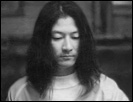Vital
- Year
- 2004
- Original title
- Vitaru
- Japanese title
- ヴィタール
- Director
- Cast
- Running time
- 86 minutes
- Published
- 4 August 2004



by Tom Mes
After spending years covering the human body in scrap metal (in the Tetsuo films), bruises, wounds, and scars (in Tokyo Fist and Bullet Ballet), and dirt (in Gemini), Shinya Tsukamoto was finally comfortable enough to expose it in all its naked glory in A Snake of June. Asuka Kurosawa's liberation from emotional and physical repression while masturbating in the pouring rain took Tsukamoto on a new course. But with the skin as a seemingly obvious endpoint, it was a course that begged the question "Where to next?"
Continue in the same direction, is the logical yet surprising answer. With Vital he digs deeper, past the skin and into the body, his camera exploring our innermost like the modern-day equivalent to Leonardo DaVinci's sketchbook. Rest assured, though, for just as A Snake of June steered well clear of exploiting the topic of female sexuality, Vital wisely avoids lingering close-ups of quivering organs and bloodsoaked body cavities. Tsukamoto's goal is a much more philosophical one; his search is for our individual consciousness and where in our bodies we might find it.
Hiroshi (Asano, who previously worked with the director in Gemini) is a medical student plagued with amnesia after a road accident that took the life of his girlfriend Ryoko (newcomer Nami Tsukamoto, no relation). Settling back into his parents' concrete apartment with his mind a blank sheet, he sleepwalks through the days like a ghost. The discovery of an anatomy textbook rekindles memories of his devotion to his medical studies and as the recollections, particularly those of his girlfriend, slowly start to flow back, he decides to re-enter university and pick up where he left off. When the body on his class dissection table turns out to be that of Ryoko, Hiroshi starts a feverish search for their shared past, hoping to find what was lost by digging it up from inside her preserved corpse.
Up to this point, Tsukamoto's work, despite the popular conception of him as a sci-fi filmmaker, has always had a very strong social relevance. Dealing with the rediscovery of the feelings that were numbed by the drudging routine of urban life, his films have been chronicles of contemporary everyday existence. Essentially reworking this pattern from film to film in true auteurist sense, adding different nuances each time, he seemed to have come to the end of his quest with the aforementioned A Snake of June, which saw the first attempts at separating the motif of reawakening human feelings from the context of life in the city.
Vital affirms this conclusion. Here, for the first time, the director operates on a much more abstract level. Hiroshi regaining his memory and submerging himself in the bliss of his lost love still follows the same pattern as Tsukamoto's previous protagonists, but nearly all connections with the urban surroundings as a cause have been severed. To all intents and purposes, Vital shows us a Shinya Tsukamoto who is totally free, a filmmaker starting a new stage in his work - an artist reborn.
What this means for us as viewers is the great joy of watching a film of deep emotional resonance. Gone is the pounding, the metal hammer with which the director wanted to smash us over our skulls in his previous work. Tsukamoto always knew how to reach his audience deep inside, but instead of giving them a direct punch to the gut, with Vital he gradually fills them with a warmth that builds and builds as the film's 86 minutes pass. And he achieves it without surrendering an inch of his trademark intensity. Intense this time is not the noise, the machine-gun editing, or the violence, but the beauty. With Vital, Shinya Tsukamoto has made an intensely beautiful film.